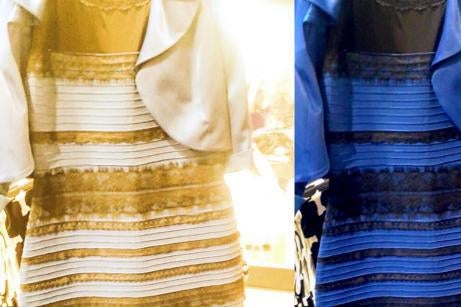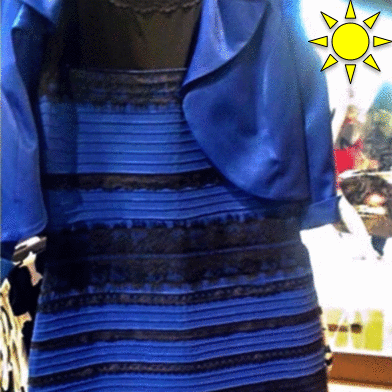Where Did White and Gold Dress Come From
Two Years Later, We Finally Know Why People Saw "The Dress" Differently
Remember "the dress"? It disrupted our understanding of color, and, yes, it took science two years to catch up.

One of psychologist Robert Zajonc's lasting contributions to science is the "mere exposure effect," or the observation that people tend to like things if they are exposed to them more often. Much of advertising is based on this notion. But it was sorely tested in late February 2015, when "the dress" broke the internet. Within days, most people were utterly sick of seeing or talking about it. I can only assume that now, two years later, you have very limited interest in being here. (Thank you for being here.)
But the phenomenon continues to be utterly fascinating to vision scientists like me, and for good reason. The very existence of "the dress" challenged our entire understanding of color vision. Up until early 2015, a close reading of the literature could suggest that the entire field had gone somewhat stale—we thought we basically knew how color vision worked, more or less. The dress upended that idea. No one had any idea why some people see "the dress" differently than others—we arguably still don't fully understand it. It was like discovering a new continent. Plus, the stimulus first arose in the wild (in England, no less), making it all the more impressive. (Most other stimuli used by vision science are generally created in labs.)

Slate
Even outside of vision scientists, most people just assume everyone sees the world in the same way. Which is why it's awkward when disagreements arise—it suggests one party either is ignorant, is malicious, has an agenda, or is crazy. We believe what we see with our own eyes more than almost anything else, which may explain the feuds that occurred when "the dress" first struck and science lacked a clear explanation for what was happening.
Two years later we have a much better idea of what may have been a reason for the varied perceptions: People's perceived color is also informed by their perception of lighting. And the image of the dress, taken on a cellphone, contained a lot of uncertainty in terms of lighting conditions. Was it taken inside or outside? This matters because it implies artificial or natural light. Was the dress illuminated from the front or the back? This matters because if it was back-lit, it would be in a shadow, otherwise not.
The brain cannot be accused of epistemic modesty. It is well-known that in situations like this—where it faces profound uncertainty—it confidently fills in the gaps in knowledge by making assumptions. Usually, its assumptions are based on what it has most frequently encountered in the past. For instance, if the sensory information is more uncertain, observers will estimate object speeds to be slower than they actually are, presumably because slow objects are much more common in the environment than fast ones. (Indeed, most objects in any given field of view don't move at all.) Color and lighting are no exception.
As the illumination conditions are impossible to clearly assess in the dress image, people make assumptions about what they are. Different people do this in differing ways, which is what causes the different interpretations of color. At least, that's what my research shows, thanks to 13,000 people, including many Slate readers, who took surveys on what they saw when they saw the dress and also compiled other information about how they generally perceived the photo and the world.
Remember, the dress is actually blue and black, though most people saw it as white and gold, at least at first. My research showed that if you assumed the dress was in a shadow, you were much more likely to see it as white and gold. Why? Because shadows overrepresent blue light. Mentally subtracting short-wavelength light (which would appear blue-ish) from an image will make it look yellow-ish. Natural light has a similar effect—people who thought it was illuminated by natural light were also more likely to see it as white and gold. Why? Because the sky is blue, daylight also overrepresents short wavelengths, compared with relatively long-wavelength artificial (until recently, usually incandescent) light. Just as mentally subtracting blue light leaves the image looking more yellow, mentally subtracting yellow light from an image leaves an image looking more blue, which is what I found empirically.
Now, why would some people assume one set of lighting conditions and others a different one? That probably depends on the viewing history of the individual observer. How would one study that? One can hardly ask people if they are exposed to more short- or more long-wavelength light. Chances are that most people wouldn't know and definitely would not be able to assess how their histories of light perception is different relative to other people.
I could make one confident prediction, though: All else being equal, people who rise early ("larks") and go to bed at a reasonable time should be exposed to more daylight than those who rise late and go to bed later ("owls"). In contrast, owls could be expected to experience relatively more incandescent light than larks.
It is important to note that everything else is likely not equal. So I expected to find a subtle effect that takes data from thousands of observers to be established. For instance, even if even if someone was a hardcore owl, he or she might be forced by circumstance to work a job that makes him or her get up early.
And this is exactly what I found—the effect is subtle but statistically reliable and dose-dependent; in other words the more someone self-identified as a lark, the more likely he or she was to see the dress image as white and gold. Moreover—and to tie everything up with a bow— owls were more likely to assume that the lighting was artificial, not natural.
As the effect is subtle—really a proxy for illumination exposure history that cannot be expected to correlate perfectly, one should not expect this to hold for every individual observer. Even if someone spends most of their waking time at night, he or she might not use incandescent lighting. But on average, this group will be exposed to more incandescent light than the larks.
As a matter of fact, I can legitimately be accused of being a fairly extreme owl, yet I initially saw "the dress" strongly as white and gold. However, I did assume it to be in a shadow, so that assumption seemed to override the other. Moreover, viewing histories can change. Admittedly, I looked more at images of dresses (and this specific one at that) in the days following "the dress" than in my entire life before that combined. And it quite abruptly changed to a black and blue percept after four days, and I have never seen it as white and gold again. Of course, I also learned the true color of the dress in the intervening time, and my research suggests that people are more likely to switch to the true color of the dress than vice versa. Some people probably have such finely balanced assumptions that any number of factors could yield their percept to switch rapidly. These people are rare. They need to be found and studied in labs.
Regardless, this point about subtle effects under complicated conditions is an important one. Making the claim that self-identified circadian type can influence perception is unusual. And I wanted to get it right, so I did an internal replication of these findings before seeking publication, which delayed publication by well over a year. (I had 97 percent of the data from the original run within a month of the dress release and could have published right then and there.)
This brings me to the final reason why the dress is important: It's been over two years since "the dress," but this paper and another one that just came out represent the first truly rigorous studies on the dress effect.
Good science takes time. I want to be comfortable that my findings are true before publishing them, so that they will stand the test of time. Yet this approach is remarkably uncommon. Given our current science environment, all incentives are aligned to rush to publication and to prioritize quantity over quality of papers. If this is the case, it should not be surprising that scandals—putting entire bodies of work into question and possibly invalidating decades of work—surface with some regularity. Indeed, most of science is currently mired in a "replication crisis," with only about 1 in 4 reported findings standing the test of time in social psychology. The situation is likely even worse in fields like cancer biology or genomics.
All of this suggests that we need to change the way we do science. Civilization needs reliable, high-quality science to advance further. Unlikely as it might seem from the outside, research on "the dress" could lead the way.
On that note, please take this brief (five-minute) survey in the spirit of #citizenscience. So as not to taint the results, we can't talk too much about what we are testing here, but the purpose is to address some lingering questions about the dress effect and related stimuli. And please bear with me and my colleagues talking about this for years to come.
Source: https://slate.com/technology/2017/04/heres-why-people-saw-the-dress-differently.html
0 Response to "Where Did White and Gold Dress Come From"
Post a Comment